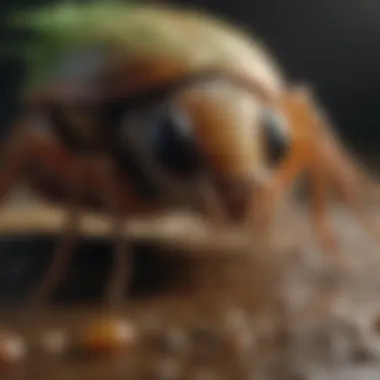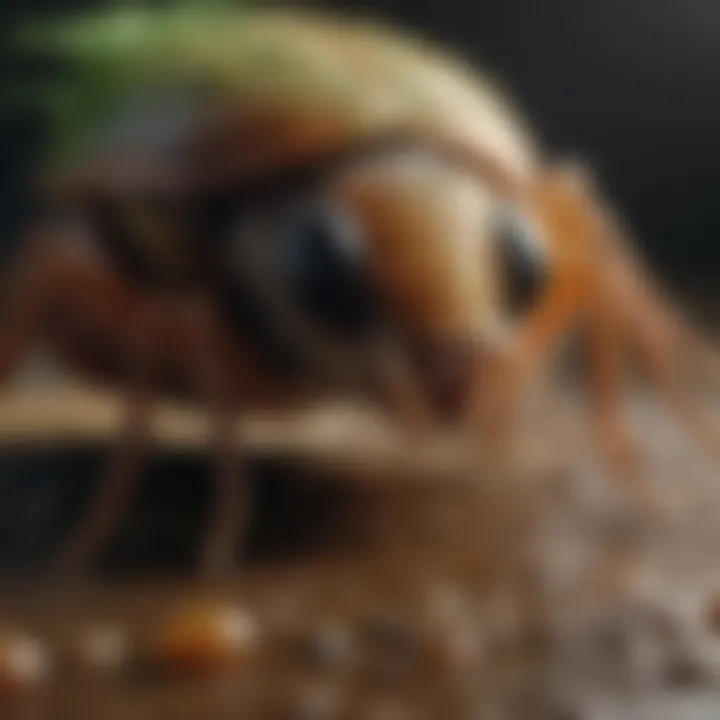Microbial Insecticides: Transforming Pest Management


Intro
Microbial insecticides represent a significant advancement in the field of pest control within agriculture. Their rise reflects a shift towards more sustainable practices that prioritize environmental health and long-term efficacy. This article aims to bridge the gap in knowledge regarding microbial agents, their benefits, limitations, and applications, providing both new and experienced farmers with valuable insights.
Topic Overview
Definition and Importance
Microbial insecticides are biological agents derived from microorganisms, such as bacteria, fungi, and viruses, that target specific pests while minimizing harm to non-target organisms. Their importance lies in their ability to control pest populations effectively, reducing reliance on synthetic chemical pesticides. This shift is crucial, as it addresses growing environmental concerns and promotes sustainable farming methods.
Brief History and Evolution
The use of microbial agents for pest control can be traced back to traditional practices in various cultures. In the early 20th century, interest in biological pest control grew. The introduction of Bacillus thuringiensis in the 1950s marked a turning point, establishing microbial insecticides as viable alternatives to chemical pesticides. Over the decades, advancements in biotechnology and genetic engineering have further enhanced their efficacy and application scope.
Key Techniques and Innovations
Sustainable Farming Practices
Integrating microbial insecticides within sustainable agriculture has distinct advantages. They reduce chemical residues in the environment and minimize risks to beneficial insects, such as pollinators. Additionally, microbial insecticides can enhance soil health and contribute to biodiversity, which is fundamental for resilient farming systems.
Advanced Agronomic Technologies
Technological advancements have facilitated the customization and precision of microbial insecticides' applications. Techniques such as encapsulation and targeted delivery systems allow for more effective pest management while reducing wastage. Innovations in application methods, such as drones and smart sprayers, also optimize the use and effectiveness of these biocontrol agents.
Practical Applications
Step-by-Step Guides
- Identification of Pests: The first step involves accurately identifying the pest species to apply the appropriate microbial insecticide.
- Selection of Agent: Choose a microbial insecticide based on the target pest’s biology and the environmental conditions specific to your farm.
- Application Timing: Timing is crucial. Apply microbial insecticides when pests are most vulnerable, typically during their early growth stages.
- Monitoring: Post-application, monitor pest populations and crop health to assess the effectiveness of the microbial agent and adjust as needed.
Case Studies or Real-World Examples
Several case studies illustrate the successful application of microbial insecticides. For instance, the use of Bacillus thuringiensis in cotton and corn crops has led to significant reductions in pest populations without major side effects on surrounding ecosystems. Similarly, research conducted on Beauveria bassiana demonstrates its efficacy as a biopesticide against various agricultural pests, bolstering farmer interest in microbial solutions.
Preamble to Microbial Insecticides
Microbial insecticides have emerged as a pivotal element in modern agricultural practices. As the pressures of pest resistance and environmental concerns escalate, farmers and agricultural professionals increasingly turn to these bio-based solutions. Understanding the intricacies of microbial insecticides is essential for grasping their potential impact on both crop health and ecosystem sustainability.
The importance of microbial insecticides lies not only in their efficacy against specific pests but also in their role within integrated pest management (IPM) systems. These insecticides, derived from naturally occurring microorganisms such as bacteria, fungi, viruses, and nematodes, offer numerous advantages over traditional chemical pesticides. They reduce chemical residues in the environment, maintain crop biodiversity, and present a lower risk for non-target organisms, including beneficial insects.
Moreover, microbial insecticides exhibit a unique mechanism of action that can be tailored to specific pest populations. This specificity helps minimize the impact on beneficial insects and promotes a healthier agricultural ecosystem.
"Microbial insecticides are a crucial step towards sustainable agriculture, combining effectiveness with environmental preservation."
As farmers face the dual challenges of meeting global food demands and adhering to environmental regulations, the exploration into microbial insecticides becomes increasingly relevant. They not only support pest control goals but also align with sustainable farming practices that aim to reduce reliance on harsh chemicals. In light of these considerations, understanding microbial insecticides is no longer a niche subject. It is a fundamental area of knowledge that all agricultural stakeholders must engage with to promote a more resilient and sustainable farming future.
Understanding Microbial Insecticides
Microbial insecticides represent a significant shift in the approach to pest management within agriculture. Understanding them is crucial not just for agronomists but for any farmer seeking sustainable solutions. These biological agents leverage natural microorganisms to target harmful pests, minimizing the ecological footprints often associated with conventional chemical insecticides. Awareness of microbial insecticides leads to an appreciation of alternative methods that are increasingly necessary in modern agriculture.
Definition and Nature
Microbial insecticides are formulated using microorganisms such as bacteria, fungi, nematodes, and viruses, specifically to control pest populations. These products differ from traditional insecticides in that they utilize living organisms to disrupt the lifecycle of pests instead of relying purely on synthetic chemicals. This approach aligns with the growing demand for environmentally-friendly agricultural practices. They often exhibit a higher safety profile for non-target organisms, including beneficial insects and larger animals.


Types of Microbial Insecticides
Numerous categories exist within microbial insecticides, each contributing to pest management in its unique way. Understanding these types is essential for effective application and performance optimization.
Pathogenic Bacteria
Pathogenic bacteria, such as Bacillus thuringiensis, play a pivotal role in microbial insecticides. These bacteria produce proteins that are toxic to specific insect larvae. Their key characteristic is that they are highly selective, targeting only certain pests without harming beneficial insects or other organisms. This selectivity makes them a popular choice among farmers who wish to maintain biodiversity in their fields. However, the unique feature that stands out is their ability to adapt and persist in the environment, which can be an advantage in long-term pest management strategies.
Fungi
Fungal agents harness the infection mechanisms of various fungi, such as Beauveria bassiana. They act by penetrating the insect's cuticle, leading to mortality. A key characteristic of fungi is their ability to spread rapidly under conducive humidity and temperature conditions, making them effective in diverse environments. They are often seen as beneficial in organic farming due to their natural origins. Nevertheless, their effectiveness can be limited by adverse weather conditions, which may hinder application outcomes.
Nematodes
Nematodes, particularly Steinernema and Heterorhabditis species, are another class of microbial insecticides. These microscopic roundworms seek out pests in the soil and release symbiotic bacteria that kill the host insect. Their main characteristic is that they are non-target specific, meaning they can affect a broad range of soil-dwelling insects. This broad-spectrum capability provides a robust option for farmers dealing with various pest issues. On the downside, their efficacy can be influenced by soil conditions, such as moisture and temperature, which must be monitored closely for successful application.
Viruses
Viruses, like the nucleopolyhedrovirus, are also crucial in microbial insecticide formulations. These viruses infect specific insect hosts, leading to their eventual death. A key feature is their specificity. They usually target only specific insect species. This is a considerable advantage because it minimizes the risk to beneficial insects. However, on the downside, the relatively slower action of viral agents compared to chemical insecticides can limit their immediate effectiveness, making them more suitable for pest populations that can be managed over time.
Mechanisms of Action
Understanding the mechanisms of action for microbial insecticides is crucial for comprehending how these agents effectively control pest populations. These mechanisms involve interactions at the biological level between the microbial agents and their target insect species. This knowledge aids farmers in selecting appropriate agents for specific pest issues, contributing to more successful pest management practices. By exploring how microbial agents disrupt normal physiological functions in insects, we can better appreciate their potential benefits as eco-friendly pest control solutions.
How Microbial Agents Affect Insects
Microbial agents such as specific bacteria, fungi, and viruses operate through their pathogenic properties. The bacteria Bacillus thuringiensis is a prominent example. When ingested by target insects, it produces toxins that disrupt the gut lining, leading to internal damage and ultimately death.
- Physical Impact: It creates paralysis and stops feeding, which results in starvation of the insect.
- Systemic Infection: Some formulations can also invade the insect’s bloodstream, leading to a systemic infection.
- Lethal Reactions: Viruses and fungi can also cause lethal infections, ensuring that the pest populations are significantly reduced.
These agents often display specificity towards certain insect types, thus maintaining the balance in the ecosystem. Unlike traditional chemical insecticides, which may affect beneficial species, microbial insecticides can target pests with less unintended impact on non-target organisms.
Targeting Insect Physiology
The method by which microbial insecticides target insect physiology is multifaceted. They influence key biological pathways and processes in pests, which prevents their survival and reproduction. Different classes of microbial insecticides have distinct physiological targets, enhancing their effectiveness.
- Receptor Interaction: For instance, bacterial toxins bind to specific receptors in the insect gut, disrupting normal gut functioning.
- Immune Suppression: Some fungi, once inside the insect body, may suppress the immune system, making the insect more vulnerable to subsequent infections.
- Hormonal Disruption: Certain microbial agents can interfere with hormone regulation in insects, affecting their growth and development.
This targeted approach not only minimizes collateral damage to beneficial species but also promotes sustainable agriculture by reducing reliance on broad-spectrum chemicals.
"Microbial insecticides offer a path to systematic pest management, fostering ecological balance while ensuring crop health."
Advantages of Microbial Insecticides
Microbial insecticides offer distinct advantages that set them apart from traditional chemical pest control methods. As the agricultural industry increasingly seeks sustainable solutions, the relevance of these insecticides cannot be overstated. Here, we will delve into three significant benefits: environmental benefits, target specificity, and resistance management.
Environmental Benefits
Microbial insecticides are often lauded for their reduced environmental impact. This is primarily because they are naturally occurring organisms that do not accumulate in the environment. Some key aspects of their environmental advantages include:
- Decreased Chemical Residue: Unlike synthetic insecticides, microbial agents break down naturally, leading to lower chemical residues in the soil and produce. This supports healthier ecosystems.
- Biodiversity Preservation: Microbial insecticides are generally more selective than chemical alternatives. Their use minimizes harm to non-target organisms, including beneficial insects, birds, and even mammals.
- Soil Health Improvement: By promoting healthy microbial populations in the soil, such insecticides can contribute to improved soil structure and fertility. This aspect is crucial for sustainable farming practices.
"Sustainable pest control can significantly enhance soil health and biodiversity while promoting robust agricultural systems."
Target Specificity


One of the primary reasons for the adoption of microbial insecticides is their ability to target specific pests while leaving beneficial species unharmed. This precision can be broken down into several components:
- Mode of Action: Each type of microbial insecticide operates through unique mechanisms. For example, Bacillus thuringiensis, a common bacterium, specifically affects caterpillars, sparing beneficial insects like bees and ladybugs.
- Reduced Non-Target Effects: By minimizing the risk to non-target species, microbial insecticides not only protect biodiversity but also reduce potential economic loss from killing beneficial organisms that naturally control pests.
- Integrated Pest Management (IPM): The specific nature of these agents allows farmers to integrate them seamlessly into IPM strategies. This minimizes reliance on broader-spectrum pesticides that can lead to resistance.
Resistance Management
The increasing problem of pest resistance to chemical pesticides calls for alternative methods of pest control. Microbial insecticides can play a vital role in this context due to the following factors:
- Diverse Modes of Action: Microbial insecticides, which come from various organisms, can disrupt insect growth and reproduction in different ways. This diversity can hinder the ability of pests to develop resistance.
- Combination Strategies: When used alongside chemical insecticides, microbial agents can help manage resistance more effectively. This approach extends the lifespan of existing chemical tools while minimizing pest adaptation.
- Reduced Selection Pressure: By adding microbiological approaches in pest management, farmers can reduce the frequency with which pests are exposed to synthetic chemicals. This leads to lower selection pressure and therefore a slower development of resistance.
Challenges and Limitations
The integration of microbial insecticides in agricultural practices is not without its challenges. Understanding these limitations is vital for farmers looking to adopt these innovative solutions. While microbial insecticides offer significant advantages, such as environmental safety and target specificity, they also present certain obstacles that need to be addressed for successful implementation in pest control.
Efficacy Concerns
Efficacy is a primary concern when considering microbial insecticides. While these products are based on natural organisms, their effectiveness can vary significantly depending on environmental conditions. Factors such as temperature, humidity, and soil type can influence how well these agents work. For example, some microbial formulations may struggle to persist in high temperatures or dry environments.
Additionally, the speed of action can be slower compared to chemical pesticides. This delay might be acceptable in some situations, but in cases of severe pest infestations, farmers may need immediate results. It is crucial to conduct field trials to evaluate the performance of different microbial agents under various conditions. Such tests help establish guidelines for effective use, ensuring that farmers are equipped with the right information for their specific crops and local climates.
Regulatory Hurdles
The regulatory landscape surrounding microbial insecticides often poses challenges for manufacturers and farmers. In many regions, the approval process for biological products can be complex and lengthy. Regulatory authorities require extensive testing data to prove safety and efficacy before allowing these products on the market. This requirement can be a barrier to entry for smaller companies trying to innovate in the field of pest control.
Moreover, the existing regulations primarily focus on traditional chemical pesticides. Adaptations to involve microbial solutions in these frameworks are lacking. This might lead to confusion or delays in product approval, restricting farmer access to potentially beneficial alternatives. Thus, ongoing dialogue between scientists, policymakers, and agricultural stakeholders is crucial to streamline this process and promote faster adoption of microbial insecticides.
Public Perception Issues
Public perception plays an important role in the adoption of microbial insecticides. Many consumers are becoming increasingly aware of pesticide usage and its environmental impact. While microbial insecticides are generally considered safer, there is still skepticism about their effectiveness compared to established chemical options. Misunderstandings stemming from this can lead to hesitation among farmers who may fear that using microbial products could compromise crop yields.
Educational initiatives that communicate the benefits and safety of microbial insecticides are crucial. Demonstrating success stories and sharing case studies can help bridge the gap between public perception and reality. Furthermore, acknowledging the potential of microbial solutions in promoting sustainable agriculture may resonate with consumers prioritizing environmentally-friendly practices.
"Building trust in microbial insecticides requires transparency about both their efficacy and safety."
As the agriculture sector moves towards more sustainable solutions, overcoming these challenges and limitations is imperative. By doing so, farmers can effectively incorporate microbial insecticides into their pest management strategies, paving the way for a more sustainable future.
Case Studies in Agriculture
Case studies offer invaluable real-world insight into the effectiveness of microbial insecticides. They demonstrate how these biological controls integrate into agricultural practices and influence pest management decisions. By examining specific instances where microbial insecticides have been successfully applied, farmers can gain a clearer understanding of the benefits and limitations of these methods.
In addition to understanding their efficacy, case studies also highlight how different environmental conditions and target pests influence the results. These examples allow farmers and stakeholders to learn from both successes and failures, facilitating better pest control strategies in their own operations. Moreover, the documented results from various settings contribute to forming a broader perspective on microbial insecticides, which can encourage their adoption in more widely varied agricultural landscapes.
Successful Applications of Microbial Insecticides
Successful applications of microbial insecticides include various crops and pest scenarios. For instance, in cotton farming, Bacillus thuringiensis (Bt) has proven effective against lepidopteran pests, leading to improved cotton yield. Another notable example is the use of entomopathogenic fungi in vegetable farms, where they target aphid populations without harming beneficial insects.
Practical implementations often showcase the ease of integrating microbial solutions into existing pest management frameworks. Farmers who adopted these insecticides observed not only a reduction in pest populations but also a decrease in the reliance on chemical pesticides. The combination of both factors reduces overall environmental stress.
However, proper understanding of the conditions required for these agents is essential. Factors like humidity, temperature, and the presence of alternative hosts can affect the performance of microbial insecticides.
Comparative Analysis with Chemical Insecticides
Comparing microbial insecticides to chemical alternatives reveals significant differences. Microbial solutions are generally species-specific, targeting only particular pests while preserving beneficial insects, which chemical insecticides may indiscriminately affect. This specificity reduces the risk of disrupting ecological balance.
Furthermore, microbial insecticides are more biodegradable than their synthetic counterparts. This leads to reduced residues on crops and the surrounding environment, making them more suitable for sustainable farming practices.


Despite these advantages, some limitations do remain. For example, the slower action of microbial insecticides compared to chemical ones can be a concern for farmers needing immediate results. Additionally, factors like application timing and environmental conditions significantly impact efficacy, possibly complicating their use.
"The case studies consistently show that while microbial insecticides may not entirely replace chemical alternatives, they can effectively complement existing pest management strategies."
In summary, the investigation of successful applications and the comparative analysis with chemical insecticides adds depth to the overall understanding of microbial insecticide effectiveness. By analyzing specific case studies, the agricultural community can better assess the role of these agents in integrated pest management and embrace their potential for more sustainable practices.
Microbial Insecticides and Sustainable Farming
Microbial insecticides play a crucial role in sustainable farming, representing a significant shift towards environmentally friendly pest control methods. By utilizing natural organisms to combat pests, these biopesticides align with the principles of sustainable agriculture. They minimize chemical residues on crops, reduce the risk of developing pest resistance, and promote a healthier ecosystem. The adoption of microbial insecticides can significantly reduce the dependency on synthetic pesticides, which have raised concerns over their long-term impacts on soil health and biodiversity.
Integrating Microbial Solutions into Current Practices
To effectively incorporate microbial insecticides into existing agricultural practices, farmers need to evaluate their specific pest management needs. This integration involves understanding the ecology of the farm and identifying the pests that pose the greatest threat. Knowledge of the life cycles and behaviors of these pests is essential to select the appropriate microbial agent.
Additionally, farmers should consider the timing of application to maximize the efficacy of microbial products. For instance, applying these agents during specific growth stages of crops or when pest populations are low can lead to better results. Training and education around microbial insecticides are also vital. Farmers must be educated on the operational differences between biological and chemical insecticides to adjust their practices accordingly.
Moreover, combining microbial solutions with other sustainable practices, such as crop rotation and integrated pest management, can enhance overall effectiveness. Such collaboration also promotes resilience in farming systems, reducing vulnerability to pest outbreaks.
Long-term Sustainability Goals
Long-term sustainability goals can be better achieved through the systematic adoption of microbial insecticides. These biopesticides contribute to enhanced soil health, which is foundational for sustainable farming. Healthier soils lead to improved water retention and nutrient cycling, key elements for sustainable agriculture. By using microbial options, farmers can help build a more resilient agricultural ecosystem that supports diverse flora and fauna.
Furthermore, microbial insecticides are less likely to harm non-target organisms, such as pollinators and beneficial insects. This characteristic supports the overall goal of biodiversity conservation within farming practices. By reducing reliance on hazardous chemicals, farmers can foster ecosystems that are more sustainable over time.
In summary, the integration of microbial insecticides into agricultural systems aligns with the principles of sustainability. The focus should always be on creating a balance that promotes both agricultural productivity and environmental health. This can prepare the agricultural sector for future challenges related to both pest management and ecological preservation.
Future Trends in Microbial Insecticide Development
The landscape of agriculture is shifting, and microbial insecticides are at the forefront of this change. As farmers and agronomists aim for more sustainable practices, the focus on microbial solutions is increasing. This section outlines the future trends in the development of microbial insecticides, emphasizing their significance in agricultural practices and pest management strategies.
Advancements in Biotechnology
Biotechnology plays a crucial role in enhancing the effectiveness of microbial insecticides. Research is pushing boundaries, enabling the development of new, more potent microbial strains. Recent innovations include gene editing techniques like CRISPR, which allow scientists to tailor specific traits in microbial agents. These enhancements can improve insect pathogenicity and expand the range of pests that can be targeted.
Moreover, research is focusing on the formulation of microbial insecticides. Techniques such as encapsulation or microencapsulation can protect microbial agents from environmental stressors, enhancing their longevity and effectiveness. This means that farmers can apply these solutions with greater confidence, knowing that they will remain viable for longer periods. This systematic improvement contributes to more reliable pest management, which is essential for maintaining crop yields and quality.
Market Growth and Potential
The market for microbial insecticides is projected to experience significant growth in the coming years. Factors driving this growth include the increasing demand for organic products and the necessity to reduce chemical pesticide use due to regulatory pressures and public health concerns. Farmers are becoming more educated about the benefits of microbial solutions, leading to a rise in adoption.
Consider the following points regarding market potential:
- Consumer Awareness: More consumers are seeking organic and environmentally friendly products. This trend encourages farmers to shift towards microbial insecticides, which align with sustainable practices.
- Regulatory Changes: Governments worldwide are tightening regulations on chemical pesticides, indirectly boosting the market for microbial alternatives. New policies favor biopesticides, which promotes research and investment in this area.
- Research Funding: Increased funding for agricultural biotechnology research is fostering innovation within the sector. This funding will lead to the commercialization of more effective products, further boosting market growth.
"Adopting microbial insecticides represents not only a boon for pest control but also aligns with the overarching goals of sustainable agriculture."
End
The conclusion serves as a pivotal element in this article, summarizing the overarching themes and insights surrounding microbial insecticides. It reaffirms the significance of these agents in modern agriculture, particularly in the context of sustainable pest management.
Understanding the importance of microbial insecticides cannot be overstated. With increasing concerns over chemical pesticides—ranging from environmental damage to health risks—exploring alternative methods like microbial insecticides becomes crucial. These agents not only provide effective pest control but also do so with minimal negative impact on ecosystems.
In examining the benefits, we see how microbial insecticides can improve crop yield and quality without the burden of harmful residues associated with chemical treatments. This bodes well for both farmers and consumers who are seeking safer agricultural practices.
Considerations regarding the challenges associated with microbial insecticides also merit attention. Questions of efficacy, regulatory approvals, and public perceptions are vital to address for broader acceptance in agricultural practice. A comprehensive understanding allows farmers to better navigate these complexities and optimize their pest management strategies.
Ultimately, the discussion on microbial insecticides illustrates not only their potential to revolutionize pest control but also their alignment with sustainable agriculture. As we look towards a future where food security is paramount and environmental conservation is vital, the integration of microbial insecticides can play a significant role.
"Microbial insecticides represent a pathway toward safeguarding crops while respecting ecological balance."
Through this exploration, it is clear that investing in research and development of these alternatives should be a priority. Farmers equipped with this knowledge can make informed decisions, ensuring that their practices are both effective and responsible in the grand scheme, thus encouraging a more sustainable agricultural future.



